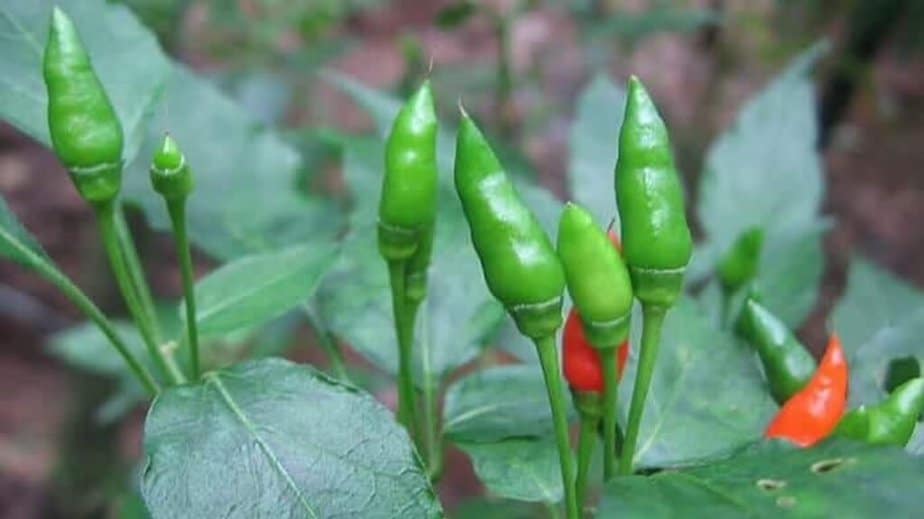The African bird’s eye pepper is a variety of small hot pepper that grows naturally in the African wild, and it’s very similar to the original Bird’s Eye Chili from Thailand. Often used in soups, hot sauces, and dishes in African cuisines, this chili is one of the hottest chilies in the world. The heat level of bird’s eye pepper (African/Piri Piri variety) can shoot up to 175,000 Scoville Heat Units.
The African bird’s eye is a small chile that is hardly an inch long but deeply hot and spicy. Also known by different names like Piri Piri, Pili Pili, or African Devil, this chile matures to red or purple and has a tapered shape with a blunt pointed tail end. In recent times, it has been commercially grown in several parts of Africa. Besides its use in cooking, pepper extract is used in pest control.
What Is African Bird’s Eye Chili Pepper
The African bird’s eye chili is a close cousin of Tabasco chili and they both belong to the Capsicum frutescens species. This hot and flavorful chili is a specialty spice of Africa and is said to be the hottest among all the different varieties of “bird” peppers.
According to the growing conditions, including soil and climate, the bird-eye plant can range in height anywhere between twenty inches to four feet. On the whole, it’s a naturally growing bushy plant with leaves of varying length from one and a half to three inches and a half to one-inch width.
The length of the pepper can vary from one-half to one inch. Initially, the pepper pods are green but they change into bright red when matured.
Just like Thai chili, African bird’s eye chili has a fruity, peppery flavor with intense heat. For most people, the green bird eye chilies are more beloved than the mature red chilies for the green ones taste more fruity and herbaceous.
African Bird’s Chili Scoville
The heat levels of Bird’s eye peppers vary according to the particular variety and the growing conditions. The Ugandan variety of Bird’s eye pepper measures up to 175,000 Scoville Heat Units and is the hottest among the lot.
According to a Scoville test done by Harald Zosche, a German farmer, each variety of this pepper has a different level of pungency. For example, according to his trial tests, the Malawi Birdseye variety which came from the African wild clocked in at 112,226 Scoville Heat Units. However, the same variety of pepper grown in his garden in Germany was measured at only 99,579 SHU. The most popular variety of Bird’s eye chili from Thailand typically ranges from 50,000 to 100,000 Scoville Heat Units.
Uses of African Bird’s Eye Pepper
African devil chili is the key ingredient in the Peri Peri Sauce, a popular African condiment made of chili, garlic, oil, and vinegar/lemon. In Africa, this chili is popularly used in soups, hot sauces, stews, and meat dishes. Also, it’s a close substitute for Tabasco pepper.
African Bird’s Eye is a flavorful addition to chili con carne, tacos, or nachos. Pureed chili is often used for spicing up marinades or as a spicy substitute for condiments like ketchup or mayonnaise.
Besides its culinary uses, this pepper has medicinal applications, especially for its pain-relieving properties for alleviating arthritis as well as toothache. Ground chilies are commonly used in pesticides and insect repellents.
Final Thoughts
In summary, the African Bird’s Eye Pepper, also known as Piri Piri or African Devil, is a small but extremely hot chili, reaching up to 175,000 Scoville Heat Units. Belonging to the Capsicum frutescens species, it’s akin to Tabasco chili and is renowned for its intense heat and fruity, peppery flavor.
This chili, which changes from green to red upon maturing, is a key ingredient in African cuisine, especially in Peri Peri sauce, and is also used in soups, stews, and meat dishes. The heat level varies by variety and growing conditions, with the Ugandan variety being the hottest.
Beyond culinary uses, it has medicinal properties for pain relief and is also used in pesticides and insect repellents.
READ NEXT: Thai Chili Substitute
